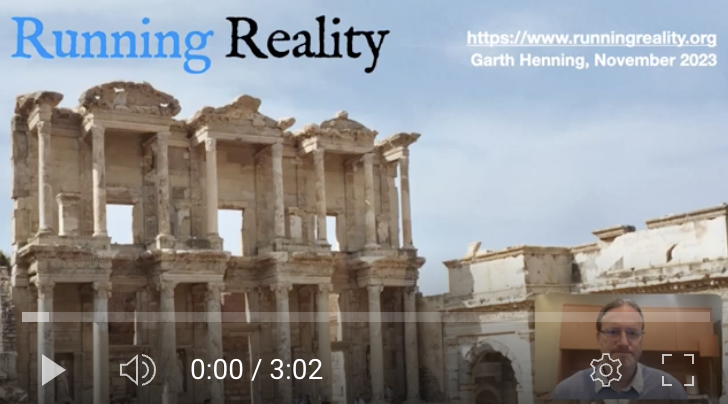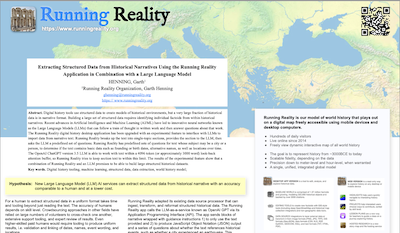Narrative and Structured Historical Data
Our hypothesis is that new Large Language Model (LLM) AI services can extract structured data from historical narrative with an accuracy comparable to a human and at a lower cost.
This article is based on a Poster Session presentation at the November 2023, 1st international conference on artificIAl Intelligence and applied MAthematics for History and Archaeology (IAMAHA) in Nice, France.
Note that this analysis was run in 2023 using OpenAI GPT-3 and GPT-4. More recent models from OpenAI, such as GPT-4o, are showing higher accuracy and lower cost than these 2023 results. Our original hypothesis looks promising for the future if there are further model improvements each year.
Video
Poster
Overview
Digital history tools use structured data to create models of historical environments, but a very large fraction of historical data is in narrative format. Building a large set of structured data requires identifying individual factoids from within historical narratives. Recent advances in Artificial Intelligence and Machine Learning (AI/ML) have led to innovative neural networks known as the Large Language Models (LLMs) that can follow a train of thought in written work and then answer questions about that work. The Running Reality digital history desktop application has been upgraded with an experimental feature to interface with LLMs to import data from narrative text. Running Reality breaks up the text into single-topic sections, provides the section to the LLM, then asks the LLM a predefined set of questions. Running Reality has predefined sets of questions for text whose subject may be a city or a person, to determine if the text contains basic data such as founding or birth dates, alternative names, as well as locations over time. The OpenAI ChatGPT version 3.5 LLM is able to work with text within a 4096 token (or approximately 3000 word) look-back attention buffer, so Running Reality tries to keep section text to within this limit. The results of the experimental feature show that a combination of Running Reality and an LLM promises to be able to build large structured historical datasets.
Methodology
For a human to extract structured data in a uniform format takes time and tooling beyond just reading the text. The accuracy of humans depends on skill level. Crowdsourcing approaches in other fields have relied on large numbers of volunteers to cross-check one another, extensive support tooling, and expert review of results. Even higher-skilled paid humans would require tooling to produce uniform results, i.e. validation and linking of dates, names, event wording, and locations.
Most historical data is in narrative form and existing structured data sets have been built at great cost and, as a consequence, can carry usage or license restrictions.

Running Reality adapted its existing data source processor that can ingest, transform, and reformat structured historical data. The Running Reality app calls the LLM-as-a-service known as OpenAI GPT via its Application Programming Interface (API). The app sends blocks of narrative wrapped with guidance instructions 1) to only use the text provided and 2) to produce JavaScript Object Notation (JSON) output and a series of questions about whether the text references historical events, such as whether a city experienced an earthquake. This capability is experimental, but is currently available to all users of the app. Running Reality is characterizing the performance of this experimental approach by assessing against narrative data sources of value to Running Reality.
Results
| Data Source | Pages | Questions | Tokens | Model | Factoids | Fully Correct % | Price |
|---|---|---|---|---|---|---|---|
| An Inventory of Archaic and Classical Poleis | 20 | 8 per section | 377755 | GPT3.5 | 46 | 52% | $0.38USD |
| GPT4 | 19 | 100% | $3.82USD | ||||
| Wikipedia | 2 | 8 per section | 143099 | GPT3.5 | 46 | 46% | $0.14USD |
| GPT4 | 16 | 88% | $1.45USD |



Fully correct factoids had all data correct and could be used in the Running Reality world history model. Mostly correct factoids had a minor error, such as a formatting error. Partially correct factoids had some data correct, such as a date or event subject or event object but had some data incorrect, such as mistaking the outcome of an event. Incorrect factoids were unusable, with no traceability to the source text.
Assessment
The results show promise, yet human supervision remains critical.
- The best results are for already quasi-structured data, such as latitude and longitude values embedded in text. However, this data is often already available fully structured.
- The worst results required differentiating event outcomes. It identified conflicts, conflict dates, and combatants, but struggled to differentiate seiged, sacked, and conquered.
- No significant difference in outcome for varying model “temperature,” which OpenAI considered a parameter to tune GPT’s creativity by increasing the variability of the output. Directing the use of only information in the context buffer and directing structured JSON output already reduced variability.
- Results from the “simpler” Wikipedia articles were not appreciable better than denser academic text. Investigation of individual errors pointed to imprecise grammar in Wikipedia articles and ambiguous event causality lowering the accuracy.
- GPT4 was 10x as expensive as GPT3.5 and produced too few factoids for effective comparison. Investigation of individual factoids showed GPT4 had a high accuracy percentage but only by avoiding even obviously described events. GPT4 results primarily matched the latitude and longitude data that was also identified accurately by GPT3.5
Considerations
- LLMs are known to confidently “hallucinate” responses that are comprised of probable words that fill gaps in its training data. Limiting “hallucinations” is critical.
- LLMs have memorized terabyte-scale training data as part of their neural network weighting parameters, which, while not explicitly traceable or cited by LLM vendors, includes vast historical data yet leaves gaps and inconsistencies of unknown scale.
-
Direct the LLM to respond based only on the input text so that the answers are based on data in the LLM context buffer, not the neural network.
- Narrative is broken into sections that fit within the token count (roughly the word count) of the LLM context buffer (4096 tokens for GPT3.5turbo, 16k tokens for GPT3.5turbo-1106)
- The content of the LLM context buffer is small but can be explicitly known, while the neural network is vast but unknown.
- Reduce the “temperature” setting of the LLM using its API to narrow probabilities in the next-word generator to narrow creativity of answers.
-
Do not ask open-ended questions.
- Ask questions which can have clear (binary) answers, that can be verified.
- Add system-level directives using the API to respond in JSON format, a structured format heavily represented in LLM training data.
- Human review of output data is essential and must be facilitated by the tool calling the LLM API, such as RR.
-
Even in high-density narrative, the number of practical structured data points is limited.
- Regardless of human or LLM
- Often require cross-referencing data to get the maximum fidelity, because event dates or locations may be elsewhere.
- Matching names with existing data challenging.
- Ambiguous temporal or geographic relationships.
- Explicit mention of alternative theories and evidence.
- Events may be described too broadly or too narrowly to match the structured data’s ontology.
- Many narrative details add richness but are not data.
Next Steps
The next steps will test additional kinds data sources and improve the RR interface with OpenAI's GPT.
- Expand from cities to people and buildings to extract locations, events, and relationships.
-
Improve accuracy on a single record by:
- Iterate exact language of queries to better distinguish events
- List all events of a given type, not just a single event per query
- Request a confidence level
-
Assess more records
- With higher per-record confidence, incur costs to assess larger numbers of records
- Develop better statistics on which kinds of data have higher confidence
- Investigate ways to make better use of GPT-4 capabilities
-
Iterate app user interface
- Facilitate human supervision to make factoid checking easier
- Link back candidate factoids to the source text
- Flag confidence level and potential alternate text to users
Acknowledgements
Running Reality collaborative assessment of “An Inventory of Archaic and Classical Poleis” is in partnership with Valentina Mignosa of the Greek History project Mapping Ancient Sicily funded by the University Ca' Foscari of Venice (PI Stefania De Vido).

